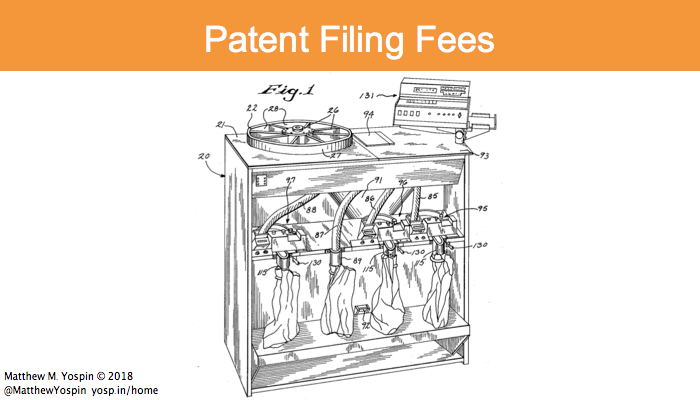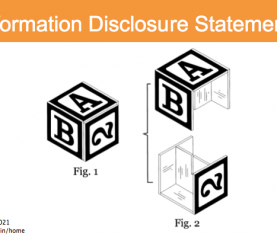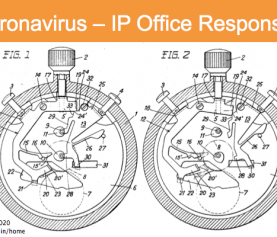Patent Filing Fees
To prepare, file, and prosecute a patent application to get a patent granted costs money. The costs fall into a few categories: cost for preparing the application (see my post on application prep costs); the USPTO patent filing fees; the patent illustrations cost (typically $75 – $125 per drawing sheet); and costs after filing for prosecuting the patent application to issuance, which likely include attorney’s fees and USPTO fees. In this blog post, I discuss the USPTO filing fees to file a patent application, and strategies to help manage them and protect your key innovations.
USPTO patent filing fees
There are many categories of USPTO patent filing fees (here is the full list at the USPTO). There are fees for filing a new application: filing, search, and examination, because for every new application filed, the USPTO will assign an Examiner to search for other relevant patents, applications, and other material, and then will examine your application in light of the other known material. In condensed form, here are those patent filing fees for a utility patent application.
Simplified USPTO patent filing fees for a utility patent application
| Type of fee | Large Entity | Small Entity | Micro Entity |
|---|---|---|---|
| Basic filing fee – Utility | $300 | $75 | $75 |
| Utility Search Fee | $660 | $330 | $165 |
| Utility Examination Fee | $760 | $380 | $190 |
| Independent claims (above 3) | $460 | $230 | $115 |
| All claims (above 20) | $100 | $50 | $25 |
| Total base filing fee, without excess claims fees |
$1,720 | $785 | $430 |
Other patent filing fees
The simplified patent filing fees laid out above are for non-provisional utility patent applications, broken out by entity filing size (for more information on that topic, see my post on large, small, and micro entity status), and assumes electronic filing. These fees disregard other possible types of filing fees, such as the fee for accelerated examination, the fees for long applications, or the fees for filing in paper, rather than electronic filings.
For provisional (utility) patent applications, the filing fees are $280, $140, and $70 respectively for applicants filing with large entity, small entity, and micro entity status, which makes filing one or more provisional patent applications a relatively affordable way to start obtaining patent protection – see my post on a staged provisional patent application strategy for one suggestion. For design patent applications and plant patent applications, the fees are lower than for utility patent applications. Total base filing fees for design patent applications are $960, $480, or $240 (large, small, micro), and total base filing fees for plant patent applications are $1,240, $620, or $310 (large, small, micro).
Patent filing fees for “excess claims”
The “excess claims” fees are charged for utility patent applications with more than 3 independent claims, or with more than 20 total claims. The rationale is that the basic examination fees covers the Examiner’s time to examine 3 independent claims, and 20 total claims – but for claims beyond that, the applicant must pay extra per claim. Each independent claim above the third costs $460, $230, or $115. Each claim above 20 total – independent or dependent – costs $100, $50, or $25.
Examples of patent filing fees for a patent application
If you have 16 total claims, but 4 of them are independent, you’ll pay the base filing fees (in the table above), plus one independent-claim fee of $460, $230, or $115. If you have 16 total claims, and only two (or three) of them are independent, you’ll pay the base filing fees, and no excess claims fees. If you have 23 total claims, and three or fewer are independent, you’ll pay the base filing fees, plus 3 total-claims fees, because 23 (your claims) minus 20 (your allotted claims) equals 3 total claims fees, that is, 3 x $100, or 3 x $50, or 3 x $25. If those 23 total claims included 5 independent claims, you’d pay the 3 total claims fees (3 x $100, or 3 x $50, or 3 x $25), plus two independent-claims fees, which will be 2 x $460, $230, or $115.
Patent filing strategy suggestions
To optimize the scope, and starting date, of your patent protection, we often recommend writing one large provisional patent application, with all variations on your inventive products or methods, and potential workarounds you can think of, described in the text of the application (the Specification) and the patent illustrations. If you’re still developing the invention, or if your budget doesn’t allow a fully-detailed provisional patent application, then my staged provisional patent application strategy might be a good solution. Then, within a year a year of filing the first provisional patent application, file one or more non-provisional patent applications. This will help to save your budget on the patent filing fees, by minimizing your excess-claims costs. This filing strategy helps you to, first, have all the information on the invention and variations in the Specification, so that each eventual patent claim (and any later amendments) can refer to the full disclosure of information in the patent application, and, second, can make examination of the patent application simpler for the patent examiner, because having fewer claims should lead to faster examination and less expensive prosecution, and third, this should save you money on excess-claims fees.
How this strategy saves money on patent filing fees
How does this strategy save money? One application’s base fee is $785 (I’m assuming you can file electronically as a Small Entity, but not as a Micro Entity, if you could, divide most of these numbers in half). You get 3 independent and 20 total claims for that price. If you add more, it is $230 per independent claim, and $50 per dependent claim.
Suppose you’re filing a patent application for a computer-implemented software method (see my post on strategies for patenting software methods). You have one method, and for that method, you have 1 independent and 4 dependent claims. You show each three times, for three perspectives. You also have 1 independent system claim, and 3 dependent, and 1 independent claim for computer-readable instructions. That’s 5 total independent claims, and 20 total claims. You pay:
$785 + $230 x (5-3) +$50 x (20-20) = $1,245.
Now suppose you have a second computer-implemented software method. It is sufficiently related to the first that you describe them both in the text of the patent application and in the patent illustrations, but you want separate claims to it. With another set of method, system, and instruction claims, writing just as many claims for the second invention as for the first, your cost for filing all of this in one patent application is:
$785 + $230 x (10-3) + $50 x (40-20) = $785 + $1,610 + $1,000 = $3,395.
But if you filed those claims in separate patent applications, you’d pay $1,245 x 2 = 2,490, which would save you $905 in this example. Of course, if you had more methods and therefore more sets of claims, the savings on USPTO patent filing fees would be larger and larger with the separate-applications strategy. When you’re planning to file one or more patent applications, consider how you’ll file them, both for strategic considerations, and also for the costs of the USPTO filing fees.
Questions about patent filing fees?
Wondering why I chose the image above for this post? It’s from US Patent 3,998,237, granted in 1976 for a coin sorter, and I chose it because determining the patent filing fees is not always as simple as sorting a pile of coins – but following a good strategy can help you to save some coins on your patent application costs. Do you have questions about USPTO patent filing fees? Call me at 617-340-9295 or email me at my Contact Me page. Or, find me on Facebook, Twitter, Google+, LinkedIn, Google Local, or Avvo.







[…] Other fees are possible for design patent applications, such as fees for length over 100 sheets, fees for accelerated examination, reissue fees, and the fee to have an allowed patent issued. (Read more about patent filing fees.) […]